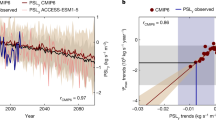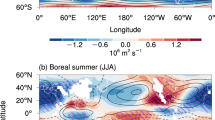Abstract
The Hadley circulation has large climate impacts at low latitudes by transferring heat and moisture between the tropics and subtropics. Climate projections show a robust weakening of the Northern Hemisphere Hadley circulation by the end of the twenty-first century. Over the past several decades, however, atmospheric reanalyses indicate a strengthening of the Hadley circulation. Here we show that the strengthening of the circulation in the Northern Hemisphere is not seen in climate models; instead, these models simulate a weakening of the circulation in the past 40 years. Using observations and a large ensemble of model simulations we elucidate this discrepancy between climate models and reanalyses, and show that it does not stem from internal climate variability or biases in climate models, but appears related to artefacts in the representation of latent heating in the reanalyses. Our results highlight the role of anthropogenic emissions in the recent slowdown of the atmospheric circulation, which is projected to continue in coming decades, and question the reliability of reanalyses for estimating trends in the Hadley circulation.
This is a preview of subscription content, access via your institution
Access options
Access Nature and 54 other Nature Portfolio journals
Get Nature+, our best-value online-access subscription
$29.99 / 30 days
cancel any time
Subscribe to this journal
Receive 12 print issues and online access
$259.00 per year
only $21.58 per issue
Buy this article
- Purchase on Springer Link
- Instant access to full article PDF
Prices may be subject to local taxes which are calculated during checkout



Similar content being viewed by others
Data availability
The data used in the manuscript are publicly available for CMIP5 data (https://esgf-node.llnl.gov/projects/cmip5/), LE (http://www.cesm.ucar.edu/), ERA-I (https://www.ecmwf.int), NCEP2 (https://www.esrl.noaa.gov/psd/data/gridded/data.ncep.reanalysis2.html), JRA55, MERRA-2 and CFSR2 (https://rda.ucar.edu/ and https://esgf.nccs.nasa.gov/projects/create-ip/) and GPCP (https://www.esrl.noaa.gov/psd/data/gridded/data.gpcp.html).
Code availability
The code for calculating the KE equation is available upon request from rc3101@columbia.edu.
References
Vallis, G. K. Atmospheric and Oceanic Fluid Dynamics (Cambridge Univ. Press, 2006).
Hartmann, D. L. Global Physical Climatology 2nd edn (Academic, 2016).
Vecchi, G. A. & Soden, B. J. Global warming and the weakening of the tropical circulation. J. Clim. 20, 4316–4340 (2007).
Kang, S. M., Deser, C. & Polvani, L. M. Uncertainty in climate change projections of the Hadley circulation: the role of internal variability. J. Clim. 26, 7541–7554 (2013).
Vallis, G. K., Zurita-Gotor, P., Cairns, C. & Kidston, J. Response of the large-scale structure of the atmosphere to global warming. Q. J. R. Meteorol. Soc. 141, 1479–1501 (2015).
Held, I. M. & Soden, B. J. Robust responses of the hydrological cycle to global warming. J. Clim. 19, 5686–5699 (2006).
Knutson, T. R. & Manabe, S. Time-mean response over the tropical Pacific to increased CO2 in a coupled ocean–atmosphere model. J. Clim. 8, 2181–2199 (1995).
Bony, S. et al. Robust direct effect of carbon dioxide on tropical circulation and regional precipitation. Nat. Geosci. 6, 447–451 (2013).
Merlis, T. M. Direct weakening of tropical circulations from masked CO2 radiative forcing. Proc. Natl Acad. Sci. USA 112, 13167–13171 (2015).
Gastineau, G., Le Treut, H. & Li, L. Hadley circulation changes under global warming conditions indicated by coupled climate models. Tellus 60, 863–884 (2008).
Gastineau, G., Li, L. & Le Treut, H. The Hadley and Walker circulation changes in global warming conditions described by idealized atmospheric simulations. J. Clim. 22, 3993–4013 (2009).
Ma, J., Xie, S.-P. & Kosaka, Y. Mechanisms for tropical tropospheric circulation change in response to global warming. J. Clim. 25, 2979–2994 (2012).
Seo, K.-H., Frierson, D. M. W. & Son, J.-H. A mechanism for future changes in Hadley circulation strength in CMIP5 climate change simulations. Geophys. Res. Lett. 41, 5251–5258 (2014).
Schneider, T., O’Gorman, P. A. & Levine, X. J. Water vapor and the dynamics of climate change. Rev. Geophys. 48, RG3001 (2010).
Levine, X. J. & Schneider, T. Response of the Hadley circulation to climate change in an aquaplanet GCM coupled to a simple representation of ocean heat transport. J. Atmos. Sci. 68, 769–783 (2011).
Taylor, K. E., Stouffer, R. J. & Meehl, G. A. An overview of CMIP5 and the experiment design. Bull. Am. Meteorol. Soc. 93, 485–498 (2012).
Quan, X. W., Diaz, H. F. & Hoerling, M. P. in The Hadley Circulation: Past, Present and Future (eds Diaz, H. F. & Bradley, R. S.) 85–120 (Kluwer Academic, 2004).
Mitas, C. M. & Clement, A. Has the Hadley cell been strengthening in recent decades? Geophys. Res. Lett. 32, L03809 (2005).
Mitas, C. M. & Clement, A. Recent behavior of the Hadley cell and tropical thermodynamics in climate models and reanalyses. Geophys. Res. Lett. 33, L01810 (2006).
Song, H. & Zhang, M. Changes of the boreal winter Hadley circulation in the NCEP–NCAR and ECMWF reanalyses: a comparative study. J. Clim. 20, 5191–5200 (2007).
Stachnik, J. P. & Schumacher, C. A comparison of the Hadley circulation in modern reanalyses. J. Geophys. Res. 116, D22102 (2011).
Liu, J., Song, M., Hu, Y. & Ren, X. Changes in the strength and width of the Hadley circulation since 1871. Climate 8, 1169–1175 (2012).
Nguyen, H., Evans, A., Lucas, C., Smith, I. & Timbal, B. The Hadley circulation in reanalyses: climatology, variability, and change. J. Clim. 26, 3357–3376 (2013).
D’Agostino, R. & Lionello, P. Evidence of global warming impact on the evolution of the Hadley circulation in ECMWF centennial reanalyses. Clim. Dyn. 48, 3047–3060 (2017).
Grise, K. M. et al. Recent tropical expansion: natural variability or forced response? J. Clim. 32, 1551–1571 (2019).
Kay, J. E. et al. The community earth system model (CESM) large ensemble project: a community resource for studying climate change in the presence of internal climate variability. Bull. Am. Meteorol. Soc. 96, 1333–1349 (2015).
Kuo, H.-L. Forced and free meridional circulations in the atmosphere. J. Atmos. Sci. 13, 561–568 (1956).
Peixoto, J. P. & Oort, A. H. Physics of Climate (American Institute of Physics, 1992).
Sohn, B.-J., Lee, S., Chung, E.-S. & Song, H.-J. The role of the dry static stability for the recent change in the Pacific Walker circulation. J. Clim. 29, 2765–2779 (2016).
Krishnan, R. et al. Will the South Asian monsoon overturning circulation stabilize any further? Clim. Dyn. 40, 187–211 (2013).
Chemke, R. & Polvani, L. M. Exploiting the abrupt 4 × CO2 scenario to elucidate tropical expansion mechanisms. J. Clim. 32, 859–875 (2019).
Davis, N. A. & Davis, S. M. Reconciling Hadley cell expansion trend estimates in reanalyses. Geophys. Res. Lett. 45, 11,439–11,446 (2018).
IPCC Climate Change 2013: The Physical Basis (eds Stocker, T. F. et al.) 1–29 (Cambridge Univ. Press, 2013).
Deser, C., Guo, R. & Lehner, F. The relative contributions of tropical Pacific sea surface temperatures and atmospheric internal variability to the recent global warming hiatus. Geophys. Res. Lett. 44, 7945–7954 (2017).
Kosaka, Y. & Xie, S. P. Recent global-warming hiatus tied to equatorial Pacific surface cooling. Nature 501, 403–407 (2013).
Sooraj, K. P., Terray, P. & Mujumdar, M. Global warming and the weakening of the Asian summer monsoon circulation: assessments from the CMIP5 models. Clim. Dyn. 45, 233–252 (2015).
Dee, D. P. et al. The ERA-Interim reanalysis: configuration and performance of the data assimilation system. Q. J. R. Meteorol. Soc. 137, 553–597 (2011).
Kanamitsu, M. et al. NCEP–DOE AMIP-II reanalysis (R-2). Bull. Am. Meteorol. Soc. 83, 1631–1643 (2002).
Kobayashi, S. et al. The JRA-55 reanalysis: general specifications and basic characteristics. J. Meteorol. Soc. Jpn 93, 5–48 (2015).
Gelaro, R. et al. The modern-era retrospective analysis for research and applications, version 2 (MERRA-2). J. Clim. 30, 5419–5454 (2017).
Saha, S. et al. The NCEP climate forecast system version 2. J. Clim. 27, 2185–2208 (2014).
Kim, H.-K. & Lee, S. Hadley cell dynamics in a primitive equation model. Part I: axisymmetric flow. J. Atmos. Sci. 58, 2845–2858 (2001).
Adler, R. F. et al. The version-2 global precipitation climatology project (GPCP) monthly precipitation analysis (1979–present). J. Hydrometeor 4, 1147–1167 (2003).
Hurrell, J. W. et al. The Community Earth System Model: a framework for collaborative. Res. Bull. Am. Meteorol. Soc. 94, 1339–1360 (2013).
Acknowledgements
Supported by the NOAA Climate and Global Change Postdoctoral Fellowship Program, which is administered by UCAR’s Cooperative Programs for the Advancement of Earth System Science (CPAESS). L.M.P. is grateful for the continued support of the US Natural Science Foundation.
Author information
Authors and Affiliations
Contributions
R.C. downloaded and analysed the data and, together with L.M.P., discussed and wrote the paper.
Corresponding author
Ethics declarations
Competing interests
The authors declare no competing interests.
Additional information
Publisher’s note: Springer Nature remains neutral with regard to jurisdictional claims in published maps and institutional affiliations.
Supplementary information
Supplementary Information
Supplementary Table and Figures.
Rights and permissions
About this article
Cite this article
Chemke, R., Polvani, L.M. Opposite tropical circulation trends in climate models and in reanalyses. Nat. Geosci. 12, 528–532 (2019). https://doi.org/10.1038/s41561-019-0383-x
Received:
Accepted:
Published:
Issue Date:
DOI: https://doi.org/10.1038/s41561-019-0383-x
This article is cited by
-
How changes in the circulation patterns specific to the solid precipitations can affect these meteorological events in the Alpine stations of the Mediterranean region? Use of the ERA5 reanalyses
Theoretical and Applied Climatology (2024)
-
Do CMIP6 models capture the observed anomalous asymmetric Hadley circulation during historical El Niño decaying stage
Climate Dynamics (2024)
-
Strengthening atmospheric circulation and trade winds slowed tropical Pacific surface warming
Communications Earth & Environment (2023)
-
Human-induced weakening of the Northern Hemisphere tropical circulation
Nature (2023)
-
Inter-model spreads of the climatological mean Hadley circulation in AMIP/CMIP6 simulations
Climate Dynamics (2023)



